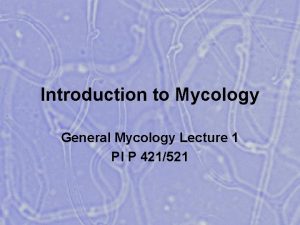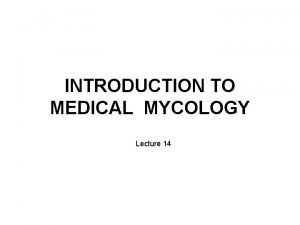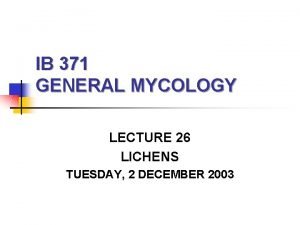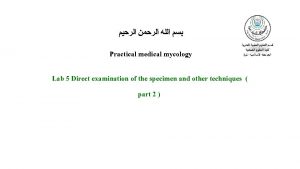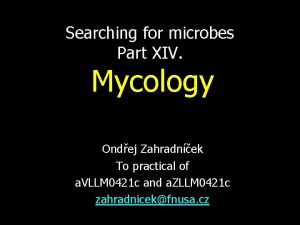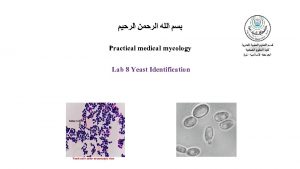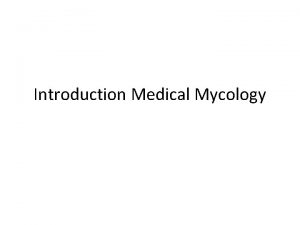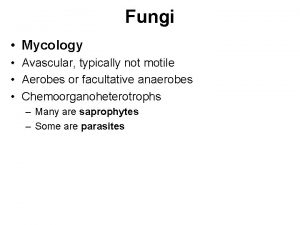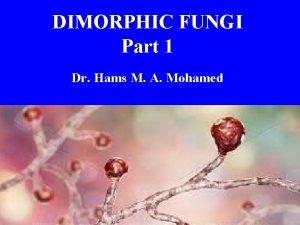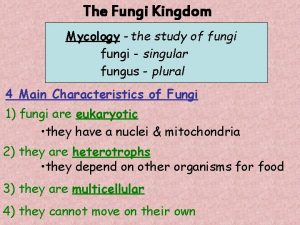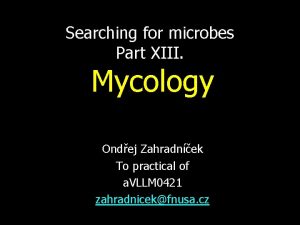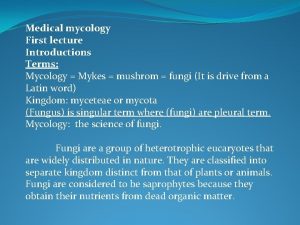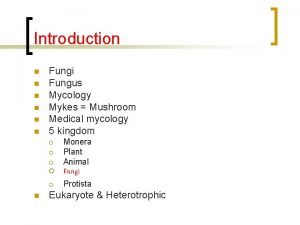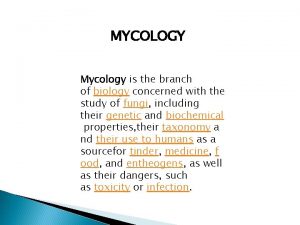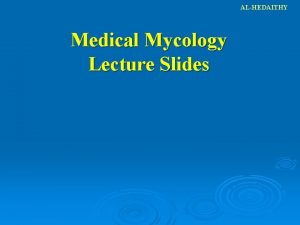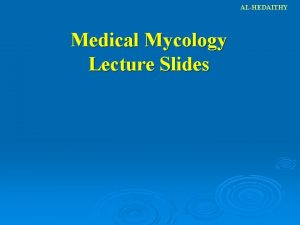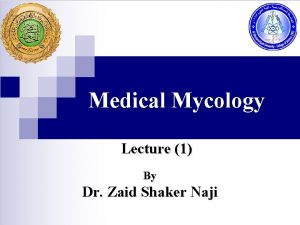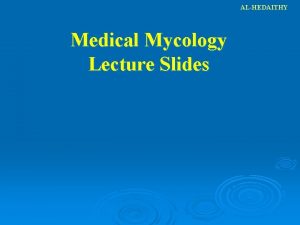Medical mycology First lecture Introductions Terms Mycology Mykes

















- Slides: 17

Medical mycology First lecture Introductions Terms: Mycology = Mykes = mushrom = fungi (It is drive from a Latin word) Kingdom: myceteae or mycota (Fungus) is singular term where (fungi) are pleural term. Mycology: the science of fungi. Fungi are a group of heterotrophic eucaryotes that are widely distributed in nature. They are classified into separate kingdom distinct from that of plants or animals. Fungi are considered to be saprophytes because they obtain their nutrients from dead organic matter.

Mykes=mushroom=fungi Logos+study of=study of fungi Kingdom mycetes (=K. fungi) Mycology Divison : Mycota Subdivision Mycotina Class: mycetes Subclass : mycetidae Order: ales Family: aceae

Molecular identification §DNa were discovered by Friedrich Miescher. In 1869 1919, Phoebus Levene identified the component of nucleic acid and coind the terms nucleotides for the individuate bases Adenine, guanine Pyramiding thymine and cytocine. Addinin will pair with thymidine and Guanine with cytosine. §The PCR technique is amplification of a part of the DNA which is present in a low concentration. §The principle of molecular phylogeny is that species are understood to have arise from mother species (their accentors) during the process of as speciation. §The two closely related species from two closely related organisms should have more unique polymorphism. As a results of mutation or recombination. §So when you compare the same piesce of. DNA sequences between different species so it is possible to infer between different species based on the polymorphism that are present. §One of the most used region for the Dan is the regions of DNA is the ribosomal DNA Operone which is consist of the small subunits (SSU), 18 s r. RNA genus the 5. 8 S r. RNA gene AND THE LARG SUBUNITES (lsu ) GET INFORMATION FROM THESIS

THIS OPERON IS PRESENT IN THE FUGNAL genom as a large number of copies § (50 -100). • The internal transcribed spacer (ITS 1 and ITS 2 are found between SSU and the 5. 8 S r. RNA gene. And the between the 5. 8 S r RNA gene and LSU respectively. The SSU and LSU evolve relatively slowly and are frequently used (50 -100). • The ssu and LSU evolve relatively slowly and are frequently used to study higher orders relationship foe examples between families or order. Where as the ITS 1 and Its 2 and 5. 8 S r. RNA gene region (often abbreviation to ITS 9 s frequently used for species level phylogeny because of the high evolutionary rate if the internal transcribed spacers. • The IGS is found at the end of LSU and start of the SSU sequence and sometimes used for the inter or intra species variation studies • Some other species which his involve other gene sequences such as B tubuline and or hailstone H 3. To sovel species and species complexity. • To use more than one gene by using multilocus sequencing to comply with the genealogical concordance phylogeniatic species recognition The kingdom fungi is they form a kingdom which is part from plant kingdom. And animals and closer to the later.

Structure of fungi Unicellular yeasts True yeses cell retain individuality Yeasts like cell attached to each other side by side forming pseudohyphae Filamentous mold hyphae-septum Septate hayphae Nonspetate hyphae coneocytic hyphae Inrerwoven hyphae =Mycelium Dimorphic: have to forms depending on changes in the environment factor like temp, medium and cultures Vs host Monomorphic only one forms regardless of environment.

Characterization distinguishing features All eukaryotic Organism Heterotrophic-don’t have chlorphyll (Acrophylous) • Saprobic • Symbiotic • Parastic The cell is surrounded by rigid cell wall made up of chitin and complex charbohydrates (chitonsan, mannan, glucan, galacotmannan) Have simple structure most of them is microscopic Reproduced by spore formation sexually or asexually The ITS sequencing


Kingdoms Animilia: (eukaryotic cells) these eukaryotes are multicellular organisms include worms, arthropods, and animals. Plantae: (eukaryotic cells) Protoctista: eukarotic single cell like protozoa and algae Monera: (prokaryotic) single cell like bacteria, actinomycetes and blue-green algae Fungi: eukaryotic non-motile include yeasts, mold, and mushroom.

Main Characteristic of Fungi: Features distinguish them from bacteria: Fungi ( Eukaryotic) Bacteria (Prokaryotic) Nucleus True nucleus Prenucleus Nuclear define nuclear membrane no well define nuclear membrane 2 membrane (the nuclear material is diffused in the cytoplasm) Cytoplasmic membrane bound no membrane bound structures organelles (Endoplasmic organelles reticulum , golgi apparatus…etc) size 1 um in size or wider it is 1 um in size or less, larger than bacteria smaller than fungi. Cell wall Composed of chitin and Composed of other polysaccharides peptidoglycan Replication Mitosis and Meiosis Simple binary fission

Features Distinguish Them From Plant: Fungi Nutritio Hetrotrophic n (achlorophllous) Saprobic (saprophytic) Symbiotic Parasitic Planta Autotrophic (photosynthesis)

Features Distinguish Them From Animilia: Cell wall Fungi Animailia Rigid cell wall mad up No cell wall of chitin and other polysaccharides (manna, glucan)

Fungi are saprophytic, aerobic, nucleated, achlorophyllous organisms, which typically reproduce sexually andor asexually. These organism usually filamentous-branched somatic structures are surrounded by true cell wall. They comprise two groups of organisms known as yeasts and molds. Structure of fungi: Yeasts: Unicellular, produced in two phase either budding yeasts cells or elongated cells attached to each other and forming pseudohyphae Culture: yeasts form colonies that resemble those of bacteria Example: Candida albicans Saccharomyces cerviseae Cryptococcus neoformance

Molds (filamentous) Molds (Mould): classified as moniliaceous (white in color) or dematiaceous (dark in color). hyphae (singular, hypha), long, slender, branching tubes. If hyphae have cross walls, the fungus is said to be Septate. If cross-walls are not present, the fungus is said to be non-septate (coenocytic). Interwoven hyphae known as mycelium Example of mold: Aspergillus sp Rhizopus sp Penicillium sp Spores and conidia are the results of asexual or sexual reproduction; they are used for the identification of the mold based on their shapes, sizes and relationship to the parent hyphae. Culture: it grows on the surface of the plates as one colony. The visible surface growth assumes a fluffy character known as mycelium. Dimorphic fungi: are mold at room temperature and yeasts at 37 oc. Example: Coccidioides imitis Histoplasma capsulatum

Reproduction in Fungi 1. Asexually 2. Sexually Asexually: asexual reproduction occurs strictly by the process of mitosis (akaryogamy) somatic spore formation The manner in which spores are produced is important in identification of fungi. Their size shape and arrangements help in the identification of fungi. Spores born in a sac-like structure called a sporangium (sporangia, pleural), and the spores know as sporangiospore. Conidia which are produced on the tip or sides of hyphae are called conidia (conidium) -it is produced on a specialized structure called conidiophore. Types of conidia Chlamydospore Blastospore Arthrospore Aleurospore

Asexual reproductive structures: Conidiophore Pycnidium Synnema Conidium Sporodochium Acervulus Imperfect fungi = Deuteromycetes: Do not reproduce sexually or their sexual reproduction not known e. g. Aspergillus, Fusarium, Candida 4

II) Sexual: Fusion, mitosis, meiosis Sexual spores: Oospore, Zygospore, Ascospore, Basidiospore Zygomycetes e. g. Rhizopus, Mucor Ascocarp Ascus Ascospore Ascomycetes e. g. Truffles Terfezia & Termania Basidiomycetes e. g. Mushrooms & Podaxis pistillaris (Agaricus campestris)

Classification of Fungi Kingdom Myceteae 1 - Div. Gymnomycota: naked (No cell wall), phagotrophic Myxamoeba, slime molds Class Acrasiomycetes, Cl. Protosteliomycetes Cl. Myxomycetes – e. g. Dictyostelium 2 - Div. Mastigomycota: flagillated, motile Cell wall, absorptive nutrition, if mold nonseptate hyphae Chytridiomycetes, Hyphochytridiomycetes Plasmodiophoromycetes, Oomycetes – e. g. Phythium, Phytophthora 3 - Div. Amastigomycota: Non flagellated, Non-motile Yeasts & molds: Septate hyphae & non-septate Cl. Zygomycetes, Trichomycetes, Ascomycetes, Basidiomycetes Deuteromycetes (Fungi Imperfecti = Imperfect fungi) e. g. Aspergillus, Penicillium, Fusarium, Candida Old terms: Phycomycetes, Aquatic, Lower fungi, Higher fungi 8
 Geofilik
Geofilik Mycology
Mycology Scotch tape preparation for fungi
Scotch tape preparation for fungi Mycology lecture
Mycology lecture Medical mycology exam
Medical mycology exam Medical mycology ppt
Medical mycology ppt 01:640:244 lecture notes - lecture 15: plat, idah, farad
01:640:244 lecture notes - lecture 15: plat, idah, farad Polynomial degrees and terms
Polynomial degrees and terms Combining like terms lesson
Combining like terms lesson Mycology
Mycology Candida albicans germ tube test
Candida albicans germ tube test Mycology test
Mycology test Aspergillus type of fungus
Aspergillus type of fungus Conidiospores
Conidiospores Dimorphic fungi examples
Dimorphic fungi examples Mycology
Mycology Metullae
Metullae Industrial mycology
Industrial mycology

